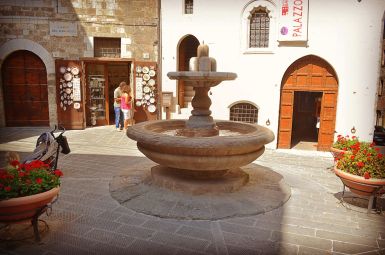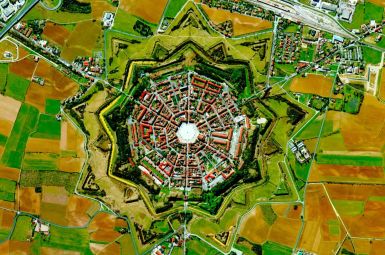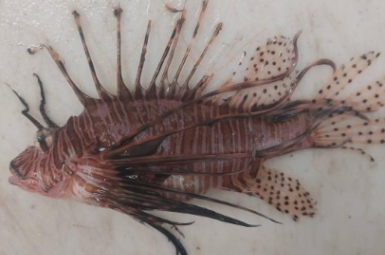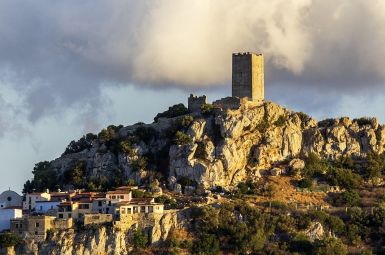
Il Borgo di Maratea
Maratea: La Perla del Tirreno tra Fede, Natura e 44 Chiese
Maratea (PZ) non è un semplice comune costiero; è un paesaggio scolpito, l’unico affaccio della Basilicata sul Mar Tirreno, dove la montagna precipita in un mare cristallino, creando una delle coste più scenografiche d’Italia. Conosciuta come la “Perla del Tirreno” e la “Città delle 44 Chiese”, Maratea offre un equilibrio perfetto tra spiritualità, bellezza naturale e charme mediterraneo. È una destinazione che conquista chi cerca non solo spiagge incontaminate, ma anche un’eredità storica e artistica di profonda intensità.Il Cristo Redentore: Il Gigante di Luce
Il simbolo inequivocabile di Maratea è l’imponente Statua del Cristo Redentore, che si erge sulla sommità del Monte San Biagio.- Fede e Panorama: Alta oltre 21 metri e rivestita in cemento bianco e scaglie di marmo di Seravezza, la statua è la seconda per dimensioni in Italia (dopo il Colosso di San Carlo Borromeo). Voluta dal Conte Stefano Rivetti, essa veglia sul borgo con le spalle rivolte al mare e lo sguardo verso la Basilica di San Biagio, proteggendo gli abitanti e la loro storia. Dalla sua posizione privilegiata, si gode un panorama mozzafiato che abbraccia l’intero Golfo di Policastro.
Costa Intatta e Fascino Marino
I 32 chilometri di litorale marateota sono un inno alla biodiversità e alla geologia.- Le 50 Calette: La costa è un susseguirsi di insenature rocciose, grotte marine e piccole spiagge, spesso accessibili solo via mare o tramite sentieri nascosti. Dalla sabbia finissima della Spiaggia Nera al fascino selvaggio di Fiumicello, ogni tratto di costa offre un’esperienza balneare esclusiva.
- Il Porto Turistico: Un pittoresco nucleo vitale, il Porto di Maratea è il punto di partenza ideale per esplorazioni subacquee e tour in barca, oltre ad essere un elegante salotto serale dove gustare la cucina locale.
Il Borgo Storico e le 44 Chiese
Il cuore antico di Maratea si aggrappa alle pendici della montagna, lontano dalla costa, con un tessuto urbano medievale intatto.- La Capitale della Fede: Il titolo di “Città delle 44 Chiese” non è un’iperbole. Tra il borgo, le frazioni e il Monte San Biagio, si contano innumerevoli edifici religiosi, ognuno custode di affreschi, opere d’arte sacra e secoli di devozione.
- Palazzo De Lieto: Nel centro storico, il settecentesco Palazzo De Lieto, oggi museo, racconta la storia civile della città e ospita mostre permanenti e reperti di archeologia subacquea, sottolineando il legame profondo di Maratea con il suo mare.
Maratea non si limita ad accogliere; invita a salire, a guardare dall’alto, a immergersi nel suo blu più profondo. Unica in Basilicata, è l’indirizzo irrinunciabile per chi cerca una vacanza dove la storia sacra e la bellezza selvaggia si fondono in un’emozione indimenticabile. Sei pronto a farti abbracciare dal Cristo?
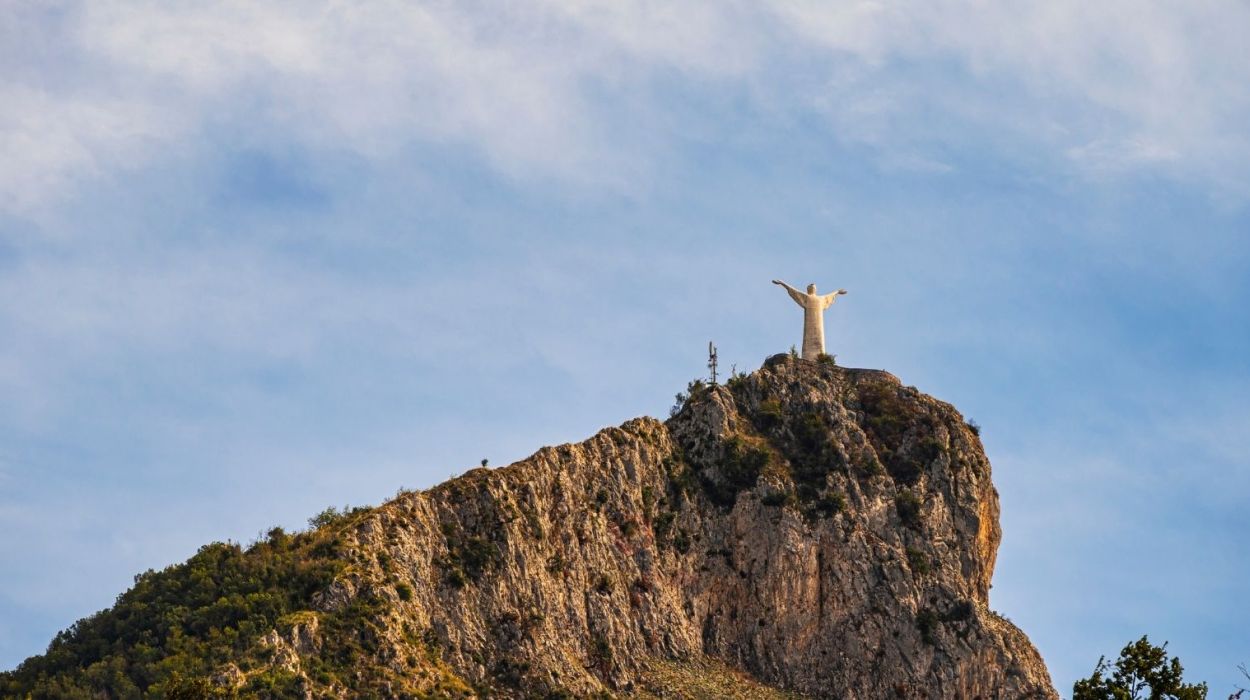
Il Borgo d’Italia
tutto da scoprire ed esplorare
Monumenti
Maratea Monumentale: I Giganti di Marmo e la Devozione sul Tirreno
Maratea (PZ), l’unica città costiera della Basilicata, non è definita solo dalla bellezza mozzafiato del suo mare, ma da un patrimonio monumentale di straordinaria forza visiva e spirituale. I suoi monumenti sono sentinelle di pietra che raccontano secoli di fede, storia marittima e un legame indissolubile tra l’uomo e la natura aspra e gloriosa del Tirreno.
Ecco i simboli architettonici e scultorei che fanno di Maratea una tappa imprescindibile per il turismo culturale nel Sud Italia.
1. Il Cristo Redentore: L’Abbraccio di Luce sul Golfo
Nessuna presentazione di Maratea può prescindere dalla sua icona più imponente, un’opera d’arte che domina l’intero Golfo di Policastro.
- Dimensioni e Materiali: Eretto tra il 1963 e il 1965, il Cristo Redentore svetta per oltre 21 metri sulla cima del Monte San Biagio. Realizzato con un impasto di cemento e scaglie di marmo di Seravezza, la statua brilla riflettendo la luce del sole, cambiando tonalità a seconda delle ore del giorno.
- Significato Profondo: Simbolo di rinascita e speranza, il Cristo ha le spalle rivolte al mare e lo sguardo fisso verso la terra e la Basilica di San Biagio. Questo orientamento voluto è un gesto di protezione verso gli abitanti del borgo, piuttosto che un semplice saluto ai naviganti.
2. La Basilica e le Rovine del Castello: La Culla della Fede
Proprio ai piedi del Cristo, il Monte San Biagio custodisce il nucleo originario della città.
- Basilica di San Biagio: Santuario dedicato al Santo Patrono, la Basilica conserva le reliquie del martire armeno, trasportate qui nel Medioevo. È un luogo di profonda venerazione e il fulcro della grande festa patronale.
- Maratea Castello: Attorno alla Basilica si trovano i ruderi del Castello di Maratea, il nucleo abitato originario, abbandonato nel XVII secolo. Questi resti sono una testimonianza austera e affascinante della vita medievale della città fortificata.
3. La Città delle 44 Chiese: Un Tesoro Diffuso
Il soprannome di Maratea come “Città delle 44 Chiese” celebra la straordinaria ricchezza del suo patrimonio ecclesiastico, distribuito tra il borgo antico e le frazioni.
- Chiesa Madre di Santa Maria Maggiore: Situata nel cuore del Borgo Antico, è la chiesa parrocchiale principale, nota per il suo pregevole organo e gli altari in marmo.
- Chiesa dell’Immacolata: Altra perla del centro storico, spesso visitata per la ricchezza degli interni e le testimonianze d’arte sacra.
4. Le Torri Costiere e il Porto: Storia di Mare
Lungo i 32 km di costa frastagliata, la storia militare e marittima è incisa nella pietra.
- Le Fortificazioni Anti-Saracene: La costa è punteggiata da sei torri di avvistamento risalenti al XVI secolo, costruite per difendersi dalle incursioni dei pirati saraceni. Questi baluardi, come la ben conservata Torre dei Crivi o il rudere della Torre di Castrocucco, offrono punti panoramici incomparabili.
- Il Porto Turistico: Non solo infrastruttura, ma un vero e proprio monumento alla vita marinara. Il porto, con le sue casette colorate a ridosso della scogliera, incarna l’anima vivace e accogliente di Maratea.
A Maratea, l’architettura non è mai statica: è un dialogo continuo tra la verticalità della fede e l’orizzontalità infinita del Tirreno. Sei pronto a scalare la storia e a scoprire le 44 gemme di questa perla costiera?
Curiosità
Maratea Segreta: Il Fascino delle Grotte, l’Enigma del Cristo e l’Eredità del Conte
Maratea (PZ) è un luogo dove il mito e la geologia si fondono, creando una costa unica nel Sud Italia. Oltre al celebre Cristo, la “Perla del Tirreno” nasconde una miriade di curiosità che rivelano una storia ricca, un patrimonio naturale eccezionale e una modernità legata all’intuizione di un visionario.
Ecco i dettagli e i segreti che rendono Maratea una destinazione da esplorare oltre i sentieri battuti.
1. L’Enigma del Cristo: Perché Volta le Spalle al Mare?
La curiosità più frequente riguardo al simbolo di Maratea, la statua del Cristo Redentore sul Monte San Biagio, è il suo insolito orientamento.
- La Protezione Territoriale: A differenza di molti monumenti costieri, il Cristo non guarda l’infinito del Tirreno. La statua è volutamente rivolta verso la terra e in particolare verso la Basilica di San Biagio. Questa scelta, voluta dallo scultore Bruno Innocenti e dal committente Conte Rivetti, simboleggia un atto di protezione e benedizione rivolto agli abitanti, al borgo storico e al santuario che custodisce le reliquie del patrono.
2. L’Intuizione del Conte Rivetti: Il Rilancio Turistico
Gran parte del fascino moderno di Maratea è dovuto all’impegno di una figura singolare che arrivò dal Nord Italia.
- Il Visionario Imprenditore: Il Conte Stefano Rivetti di Val Cervo, industriale tessile piemontese, si innamorò di Maratea negli anni ’50. Non solo commissionò la costruzione del Cristo Redentore, ma investì enormemente per trasformare il borgo in una meta turistica d’élite.
- L’Hotel Pianeta Maratea: A Rivetti si deve la costruzione del primo grande complesso alberghiero, che diede l’impulso decisivo al turismo internazionale, lanciando la città come destinazione di lusso e garantendole una fama che perdura ancora oggi.
3. Segreti Geologici e Naturalistici
Il territorio di Maratea è un vero e proprio laboratorio geologico, ricco di fenomeni carsici e biodiversità.
- La Grotta delle Meraviglie: Maratea vanta una delle poche grotte turistiche d’Italia che si sviluppa interamente sotto la Strada Statale 18. Scoperta solo nel 1929 durante i lavori per la costruzione della strada, la grotta è un gioiello speleologico con imponenti stalattiti e stalagmiti, un vero mondo sotterraneo che ha dato il nome alla località circostante (Fiumicello).
- Il Drago di Santo Janni: Sull’isolotto di Santo Janni, poco più di uno scoglio roccioso di fronte alla costa, vive una rarissima specie di lucertola, la Podarcis sicula paulae, nota localmente come “Drago di Santo Janni”. Questo endemismo è un prezioso indicatore della biodiversità unica della costa marateota.
4. La Città dalle Tante Anime: 44 Chiese e un Nome Antico
Maratea è un mosaico di storia e spiritualità diviso in nuclei distinti.
- L’Elogio del Sacro: Il soprannome di “Città delle 44 Chiese” è un attestato alla straordinaria concentrazione di luoghi di culto (chiese, cappelle, eremi e santuari) disseminati tra il borgo centrale (Maratea Superiore) e le varie frazioni costiere e collinari.
- L’Origine Greca: Il nome Maratea (o Marathia) deriverebbe dal greco antico Marathìa, che significa “terra di finocchi” (o finocchietto selvatico), una pianta abbondante sul suo territorio. Altri amano credere, più romanticamente, che derivi da màris (latino) e théa (greco), ossia “Dea del Mare” o “spettacolo del mare”.
Maratea ti invita a sollevare il velo oltre il paesaggio da cartolina: scopri il mistero delle sue grotte, la storia del suo Cristo e la bellezza nascosta in ogni angolo della costa. Sei pronto per una vacanza che è una vera e propria esplorazione?
Personaggi
Maratea: Le Personalità che Hanno Guardato il Tirreno
Maratea (PZ) è una terra di frontiera tra cielo, montagna e mare, un ambiente che plasma caratteri forti e talentuosi. Sebbene la sua fama sia dominata dal Cristo Redentore e dalle bellezze naturali, la “Perla del Tirreno” ha dato i natali a figure di rilievo nel mondo della cultura, della religione e della politica, che hanno saputo onorare la storia del loro borgo.
Ecco alcuni dei personaggi di maggior spicco originari di Maratea, i cui contributi hanno lasciato un segno.
Cardinale Domenico Rivello: La Fede e la Diplomazia (XVI sec.)
Il personaggio storico di maggior risonanza nel campo ecclesiastico legato a Maratea fu il Cardinale Domenico Rivello, il cui nome è indissolubilmente legato alla storia della Chiesa.
- Elevato Rango: Rivello raggiunse importanti posizioni all’interno della Curia Romana e fu una figura influente nel panorama politico-religioso del suo tempo. La sua carriera testimonia come anche un piccolo borgo costiero potesse dare i natali a uomini capaci di esercitare potere e influenza a livello internazionale.
I Custodi della Storia: Gli Eruditi Locali
Come molti centri storici del Sud Italia, l’importanza culturale di Maratea è stata mantenuta viva grazie a una stirpe di uomini di studio che si sono dedicati alla documentazione del proprio territorio.
- Padre Gabriele Stella (XVII sec.): Storico e religioso, fu uno dei primi a documentare in modo sistematico la storia di Maratea, inclusa la fondazione della città e le vicende legate alle sue numerose chiese. Le sue opere sono fondamentali per la conoscenza del passato marateota.
- Alessandro Mandarini (XVIII sec.): Figura di spicco nell’amministrazione civile del Regno di Napoli, fu un illuminato che si dedicò non solo alla politica, ma anche all’erudizione. Si adoperò per il miglioramento delle condizioni di vita e del patrimonio del suo paese natio, lasciando un’eredità civica duratura.
L’Arte della Musica: I Compositori e gli Artisti
Maratea ha saputo ispirare anche talenti che hanno trovato la loro espressione nel mondo dello spettacolo e dell’arte.
- Figure Contemporanee: Sebbene meno noti al grande pubblico rispetto alle star globali, diversi attori, musicisti e compositori hanno le loro radici a Maratea, contribuendo a un fermento culturale che culmina in eventi di rilievo come il Maratea Film Festival, un ponte tra il borgo e il cinema italiano.
Maratea non è solo la città del Cristo che osserva il borgo; è la culla di uomini che, da quella stessa montagna, hanno guardato il mondo, influenzando la storia e la cultura lucana. Sei pronto a scoprire le loro tracce tra i vicoli del centro storico?
Ricette Tipiche
Maratea: La Cucina del Tirreno tra Monte e Olivo
Maratea (PZ) è l’unica località della Basilicata ad affacciarsi sul Tirreno, e la sua cucina riflette perfettamente questa dualità: è un connubio tra i sapori netti e freschi del mare e gli aromi robusti e selvatici della montagna che precipita sulla costa. La gastronomia di Maratea è lussuosa nella sua semplicità, esaltata da un pescato freschissimo e dai prodotti dell’entroterra lucano.
Queste ricette sono l’espressione più autentica del territorio, dove ogni piatto racconta la storia del suo incontro tra mare e montagna.
1. I Sapori del Porto: Il Pescato Fresco
La vicinanza al Golfo di Policastro rende il pesce, cucinato in modo semplice per esaltarne la qualità, il protagonista assoluto.
I Fravaglie Fritti
Un classico della cucina popolare marinara, un piatto conviviale che celebra il pescato minuto.
- La Ricetta: Si tratta di piccoli pesci, come bianchetti o sardine di piccola taglia (il nome dialettale fravaglie indica proprio il pesce piccolo), infarinati e fritti in olio bollente. Serviti caldi, sono un antipasto o un secondo leggero e croccante, accompagnati semplicemente da una fetta di limone e un pizzico di sale.
Spaghetti con la Ricciola
Un primo piatto che eleva il sapore del mare.
- L’Abbinamento Perfetto: La ricciola (ricciola), pesce pregiato pescato localmente, viene cucinata in un sugo leggero a base di pomodorini freschi (spesso del Piennolo o datterini), aglio, prezzemolo e olio extra vergine d’oliva locale. Il sugo cremoso e saporito si sposa magnificamente con la pasta lunga fatta in casa.
2. L’Anima Contadina: Dalla Montagna alla Tavola
Nonostante il mare, la tradizione contadina lucana è forte, basata su ortaggi, legumi e sapori intensi.
Lagane e Ceci (o Fagioli)
Un primo piatto robusto e nutriente, tipico dell’entroterra ma amato anche sulla costa.
- La Pasta Povera: Le lagane sono una pasta fresca, larga e spessa, preparata senza uova. Vengono condite con un denso sugo di ceci o fagioli (spesso borlotti o cannellini), insaporiti con aglio, alloro o rosmarino e rifiniti da un filo abbondante di ottimo olio EVO e, a piacere, un tocco di peperoncino.
Salsiccia e Broccoletti (o Cardoncelli)
Il contrasto tra il sapore selvatico delle verdure di campo e la carne speziata.
- Il Secondo Rustico: Simile alla tradizione lucana, la salsiccia di maiale fresca, talvolta conservata sott’olio o sotto sugna, viene cotta con le verdure selvatiche (broccoletti o i pregiati funghi cardoncelli quando è stagione), creando un secondo piatto gustoso, un vero omaggio ai sapori della montagna.
3. Dolci e Tradizione: Il Pasticcio del Santo
Maratea vanta anche dolci semplici ma dal sapore inconfondibile, spesso legati alle festività.
Il Pasticcio di San Biagio
Un dolce tipico che celebra il patrono della città.
- Un Dolce da Festa: Si tratta di un dolce a base di pan di Spagna farcito con creme e canditi (spesso al limone o all’arancia) e ricoperto di glassa o panna. Simboleggia la celebrazione e viene preparato in particolare in occasione della Festa di San Biagio e altre ricorrenze importanti.
La tavola di Maratea è un palcoscenico di eccellenza, dove la brezza marina incontra il profumo della macchia mediterranea. Non c’è modo migliore di onorare la Perla del Tirreno che assaggiando i sapori unici della sua costa. Pronto a sederti a tavola?
